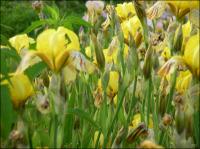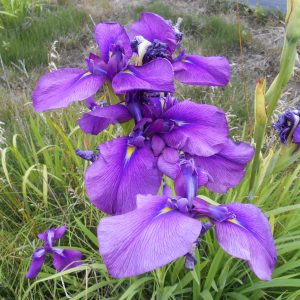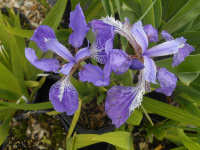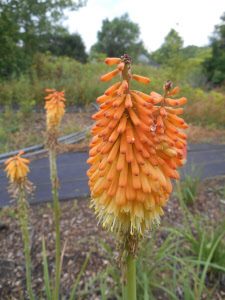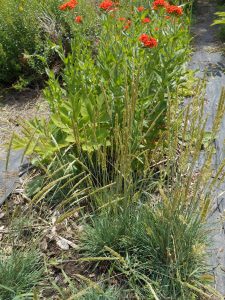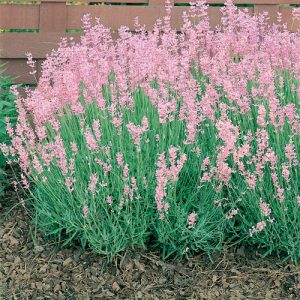Archives
Showing 89–96 of 164 results
-
Iris ‘Honorabile’ Z 4-9
Clear yellow standards with maroon striped-dashed falls
ARCHIVED
Note: This is a plant not currently for sale. This is an archive page preserved for informational use.
Clear yellow standards with maroon striped-dashed falls, blooms in mid-season
Size: 18-24" x 12"
Care: sun in moist well-drained soilFrench hybrid by Nicolas Lemon in 1840’s.
-
Iris ensata syn. Iris kaempferi Japanese iris. Called Hana-shôbu in Japan Z. 5-8
White to reddish purple flowers in early summer
ARCHIVED
Note: This is a plant not currently for sale. This is an archive page preserved for informational use.
White to reddish purple flowers in early summer
Size: 2’ x 9”
Care: moist acidic soil in full sun
Native: China, Korea and Japan
Awards: England’s Royal Horticultural Society Award of Merit.Grown in Japanese gardens for at least 1200 years (since 8th century) as a marginal aquatic plant. A symbol for beautiful women and used to dye fabric. Introduced to the west in 1690’s by Englebert Kaempfer, physician to Dutch East India Co. on Deschema Island, off the coast of Japan. “The Garden” May 20, 1876: “For many of the most beautiful varieties we are indebted to Dr. von Siebold, the celebrated German botanist, at Leyden.”
-
Iris tectorum Japanese roof iris, Wall iris, Root iris Z 5-9
In late spring violet flowers, with purple highlights, bloom above the flat, low fans of wide leaves
ARCHIVED
Note: This is a plant not currently for sale. This is an archive page preserved for informational use.
In late spring violet flowers, with purple highlights, bloom above the flat, low fans of wide leaves. It spreads into dense clumps. Rhizomes are poisonous.
Size: 12-14” X 3’
Care: sun to part shade in moist well-drained to well-drained soil
Native: Japan & Central & SW ChinaFor Japanese, a triple hitter. Women powdered rhizomes for their faces. Since at least the 7th century, Japanese grew this on their thatched roofs. It helped hold the thatching together. Folk lore also claimed it warded off evil spirits. 1st described for the West in 1871, Bulletin de l’Academie Imperiale des Sciences de St-Petersbourg.
-
Jasione montana syn J. laevis Sheep’s bit Scabious BIENNIAL Z 5-8
Globes of small blue flowers in July-August
ARCHIVED
Note: This is a plant not currently for sale. This is an archive page preserved for informational use.
Globes of small blue flowers in July-August
Size: 12” x 8”
Care: full sun in well-drained soil.
Native: Europe and Russia
Wildlife Value: attracts bees, butterflies and many other pollinators.Described by Linnaeus 1753
-
Kniphofia uvaria Red hot poker, Torch lily Z 5-10
Vibrant red and yellow spikes of tube-shaped flowers
ARCHIVED
Note: This is a plant not currently for sale. This is an archive page preserved for informational use.
Vibrant red and yellow spikes of tube-shaped flowers in early summer arise on leafless stems (called a scape) from a basal clump of strap-like leaves
Size: 2-3’ x 12-15”
Care: sun in moist well-drained to well-drained soil
Native: South Africa
Wildlife Value: deer & rabbit resistant, attracts hummingbirdsIntroduced to English gardens c. 1700 and called Alöe uvaria then renamed by English botanist Wm. Jackson Hooker. The Gardeners Dictionary (1783): “The flowers are produced in close thick spikes, upon stalks near three feet high, They are of an Orange colour…” Illustrated in Curtis’ Botanical Garden 80 (1 Nov 1854).
-
Koeleria glauca Blue hair grass Z 5-9
Erect spike-like panicles June thru August
ARCHIVED
Note: This is a plant not currently for sale. This is an archive page preserved for informational use.
Erect spike-like panicles June thru August, poke above a neat mound of erect, blue grass blades.
Size: 16" x 12”
Care: Sun in well-drained soil
Native: Siberia & Central EuropeCollected before 1800.
-
Lavandula angustifolia Lavender Z 5-9
June and rebloom in late summer, lavender spikes, fragrant
ARCHIVED
Note: This is a plant not currently for sale. This is an archive page preserved for informational use.
June and rebloom in late summer, lavender spikes, fragrant
Size: 2’ x 2’
Care: Sun, well drained moderately fertile soil
Native: Western Mediterranean
Wildlife Value: attracts butterfliesName is Latin from “lavare” meaning to wash because Romans used lavender to scent their baths. Ancient Phoenicians used lavender to make perfume. Cultivated in Islamic gardens by 1050 A.D. Queen Elizabeth, I ate lavender conserve, made by adding sugar to the flowers while Charles VI of France stuffed pillows with lavender and sat on them. Culpepper, 16th century English herbalist, wrote that lavender grew in almost every garden and cured headaches, apoplexy, dropsy, fainting, toothaches, and “passions of the heart.” Jefferson grew it with herbs at his farm, 1794.
-
Lavandula angustifolia var. rosea syn. L. spica var. rosea Lavender Z 4
Pink colored lavender flowers, and still fragrant.
ARCHIVED
Note: This is a plant not currently for sale. This is an archive page preserved for informational use.
Pink colored lavender flowers, and still fragrant. We especially like this for its compact habit.
Size: 12” x 12”
Care: sun in moist well-drained soilPink variety in gardens by 1800.

